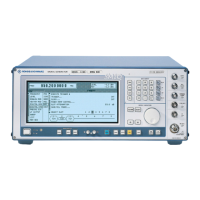SMIQ Digital Standard 3GPP W-CDMA (FDD)
1125.5555.03 E-92.225
2.14.3.2 3GPP W-CDMA Signals in the Frequency Range
For information on 3GPP W-CDMA signals in the time domain, refer to section 2.14.3.1.
The spectrum of a 3GPP W-CDMA signal (a DPCH channel) corresponds to that of a QPSK signal with
identical filter parameters.
Fig. 2-147 Magnitude spectrum of a 3GPP W-CDMA signal
If signals with several channels are investigated, a certain ripple may occur in the range +/-0.5 of the
chip rate.
Fig. 2-148 Magnitude spectrum (section) of a 3GPP W-CDMA signal with several channels
This effect can be influenced by the choice of the channelization codes and is reduced with increasing
period of observation, i.e. higher averaging for the FFT settings.
2.14.3.3 Effect of Data Source on the 3GPP W-CDMA Signal
The choice of the data sources is of vital importance for the signal characteristics. Especially the
constellation diagram and the crest factor can be modelled to a large extent by an appropriate data
selection.
Since the number of channels can be very high, particularly in the downlink, this section deals only with
the simulation of downlink signals.
In the following it is assumed that all channels are generated with the same scrambling code sequences
and the same channel powers of 0.0 dB.
A symbol rate of 60 ksps is selected.

